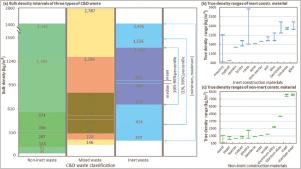Resources, Conservation and Recycling ( IF 11.2 ) Pub Date : 2021-02-11 , DOI: 10.1016/j.resconrec.2021.105480 Weisheng Lu , Liang Yuan , Fan Xue

|
Construction waste contains inert (e.g., construction debris, rubble, earth, bitumen, and concrete) and non-inert materials (e.g., bamboo, plastics, wood, paper, and vegetation), while it is often a combination of the two when it is generated at source. The bulk density of construction waste is the yardstick information for many subsequent waste management efforts. One feasible way to derive the bulk density information is to segregate the mixture of inert and non-inert substances and examine their compositions, but clearly, this is an onerous task. This paper reports a data-driven approach to obtain the bulk densities of inert and non-inert construction waste by analyzing a big dataset of 4.9 million loads of construction waste in Hong Kong in the years 2017 to 2019. It is discovered that the means of bulk density are 336 kg/m3 for non-inert waste, 528 kg/m3 for mixed waste, and 991 kg/m3 for inert waste, and their coefficients of variation are 69%, 43%, and 29%, respectively. The research not only proved our heuristic rules concerning the bulk densities of the three generic types of construction waste, but also articulated, for the first time, their converged means and ranges. The findings can be used in adjusting the admission criteria as adopted in the governmental waste management facilities. Future research is recommended to further narrow down the bulk density ranges to provide more accurate references for construction waste management.











































 京公网安备 11010802027423号
京公网安备 11010802027423号